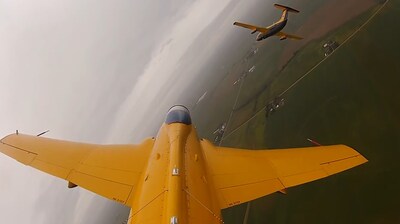Skunk Works® Demonstrates AI for Air-to-Air Tactical Intercepts
Lockheed Martin's Skunk Works demonstrated AI in air-to-air intercepts using the University of Iowa's L-29 Delfin jets. The AI conducted eight test scenarios, showing intentional and decisive behavior. This was the first live exercise of the new flight interface, exceeding performance observed in simulations. Live tests are part of a broader AI development initiative for air-to-air missions. Additional tests are planned to increase complexity and involve multiple aircraft. Lockheed Martin aims to enhance AI mission performance, adhering to ethical guidelines from the U.S. Department of Defense.
- Successful AI demonstration in live air-to-air intercept scenarios.
- Eight varied test cases executed, showing AI's intentionality and decisiveness.
- First live exercise of new flight interface exceeded simulation performance.
- Part of a broader initiative to rapidly develop and test AI-driven autonomy.
- Additional tests planned to increase complexity and involve multiple aircraft.
- No mention of immediate commercial application or revenue generation.
- Potential risks in the transition from simulation to real-world scenarios.
- Ongoing reliance on human oversight may limit full AI autonomy benefits.
Insights
The demonstration of AI for air-to-air tactical intercepts by Lockheed Martin Skunk Works is a significant technological achievement. This development showcases the integration of AI in a real-world, high-stakes application, which marks a substantial leap forward in autonomous systems. The success of these tests indicates that AI can handle complex maneuvers and decision-making processes in dynamic environments, a capability that could revolutionize air combat and defense strategies. For retail investors, this advancement emphasizes Lockheed Martin's position at the forefront of defense innovation, potentially leading to new contracts and revenue streams as military clients seek cutting-edge solutions.
From a financial perspective, Lockheed Martin's successful AI demonstration could translate into substantial long-term gains. The company's investment in AI and autonomous systems aligns with broader defense industry trends emphasizing advanced technology. This successful test might attract additional government contracts, which are important for sustained revenue growth. Investors should note that while there may be significant upfront R&D costs, the ability to deliver operationally relevant AI capabilities could open new markets and enhance Lockheed Martin's competitive edge. Additionally, future flight tests and increasing complexity in scenarios indicate a commitment to continuous improvement, which is a positive signal for long-term financial health.
The broader market implications of this AI demonstration are also noteworthy. As governments and defense bodies worldwide increase their investments in autonomous defense systems, Lockheed Martin's progress in this area positions it advantageously. The use of open mission systems standards to ensure compatibility with future platforms suggests a strategic move to integrate seamlessly with existing and upcoming defense infrastructure. For retail investors, understanding that Lockheed Martin is not just innovating but also ensuring that their technologies are adaptable and future-proof can be reassuring. This adaptability can help Lockheed Martin maintain its market leader status in the defense sector, driving long-term investor confidence.
The successful flights are a significant milestone for Skunk Works' Tactical AI team, in which AI directly flew and conducted tactical exercises with a full-scale, live aircraft – one of OPL's L-29 Delfin jets – using heading, speed and altitude commands. The team executed simulated-to-real transfer test objectives against a virtual adversary in offensive and defensive risk postures.
Eight test cases were conducted per flight to exercise the AI agent in a variety of situations, from standard head-to-head fights to off-aspect encounters, missile support and missile defeat scenarios. The team was encouraged to see clean sim-to-real transfer of learned behaviors and that the AI agent appeared intentional and decisive in its actions.
"This was the first live exercise of the new flight interface; it's thrilling to see the separate components successfully integrate on the L-29 to demonstrate new capabilities. The complete system performed even better in live flight than in simulation," said Dr. Tom "Mach" Schnell, OPL professor at Iowa Technology Institute.
"Live flight tests are a crucial aspect of advancing our expertise in AI and autonomy. These flights are powerful demonstrations of our ability to quickly and affordably develop and test operationally relevant AI capabilities," said Matthew "Gabe" Beard, Lockheed Martin Skunk Works autonomy/AI and machine learning engineering manager.
These flight tests are part of a broader initiative to rapidly develop and test AI-driven autonomy for air-to-air missions. Several other flight tests are planned for this year, building on these achievements, and increasing the complexity by introducing additional aircraft into offensive counter air and battle management scenarios. Lockheed Martin is continuously elevating AI mission performance in operationally representative simulated environments, using open mission systems standards to ensure broad compatibility and rapid transition with future platforms.
Lockheed Martin provides AI and machine learning solutions that augment human performance by processing, fusing, and analyzing tremendous volumes of data to give our customers actionable intelligence and a strategic advantage. Lockheed Martin is aligned and closely adheres to the
Lockheed Martin is a global defense technology company driving innovation and advancing scientific discovery. Our all-domain mission solutions and 21st Century Security® vision accelerate the delivery of transformative technologies to ensure those we serve always stay ahead of ready. More information at Lockheedmartin.com.
![]() View original content to download multimedia:https://www.prnewswire.com/news-releases/skunk-works-demonstrates-ai-for-air-to-air-tactical-intercepts-302163728.html
View original content to download multimedia:https://www.prnewswire.com/news-releases/skunk-works-demonstrates-ai-for-air-to-air-tactical-intercepts-302163728.html
SOURCE Lockheed Martin Aeronautics









